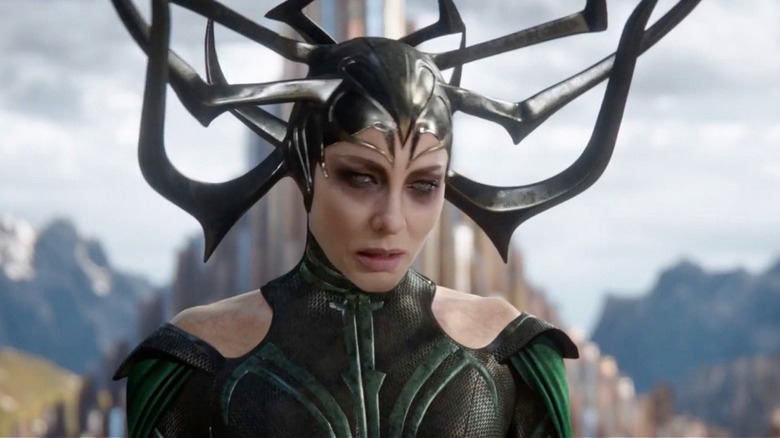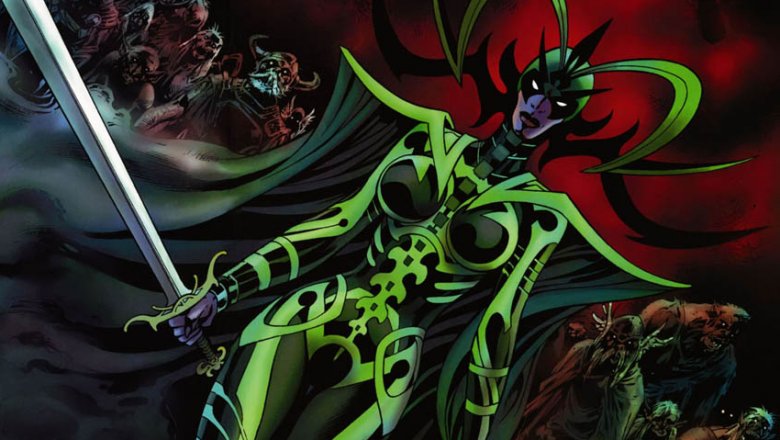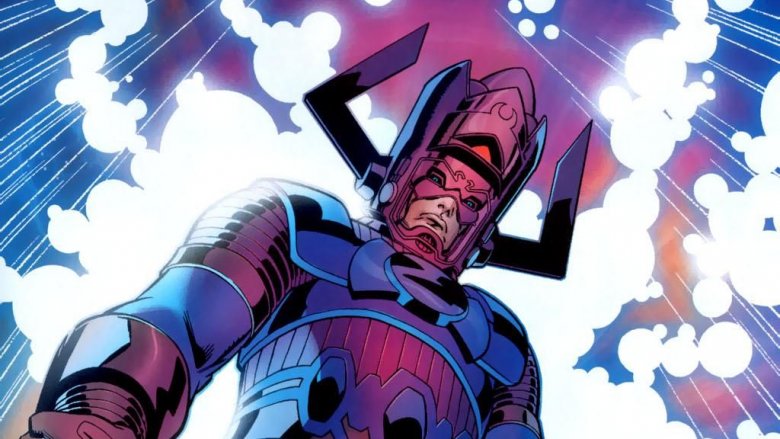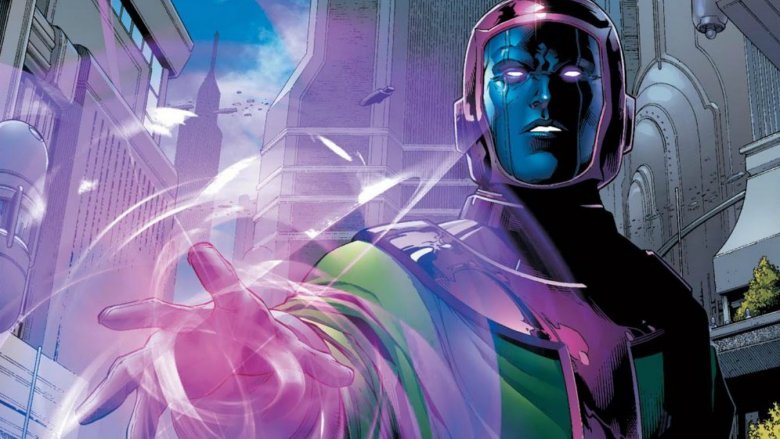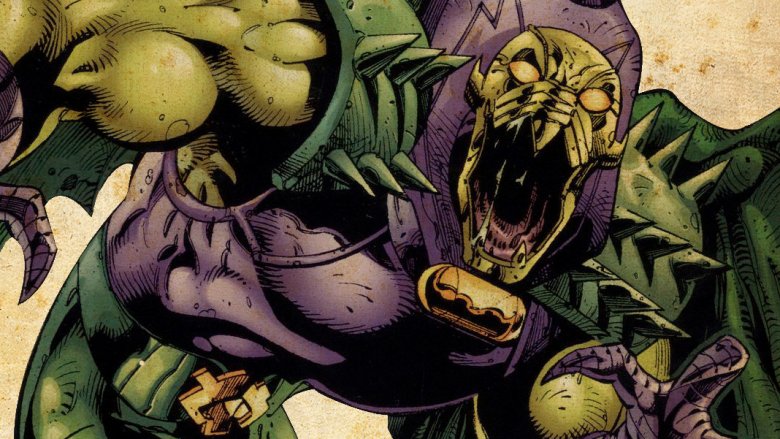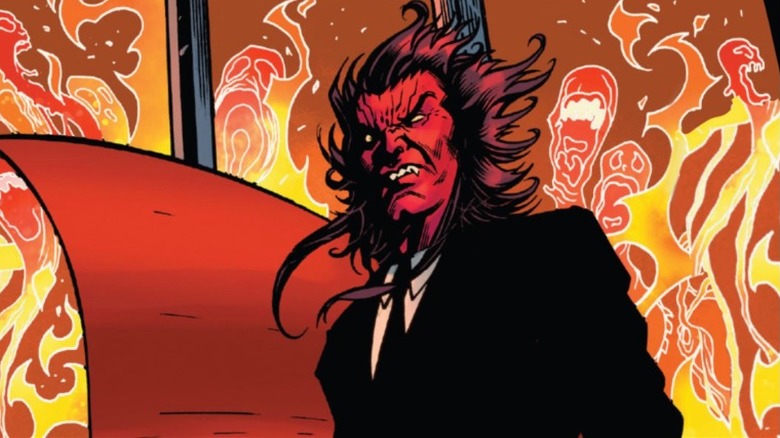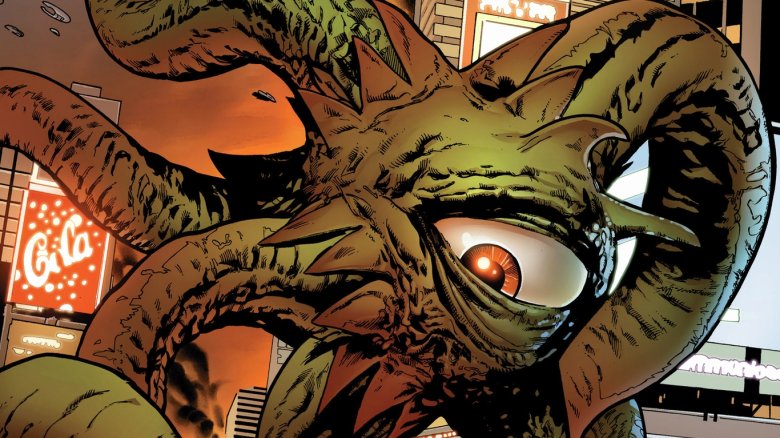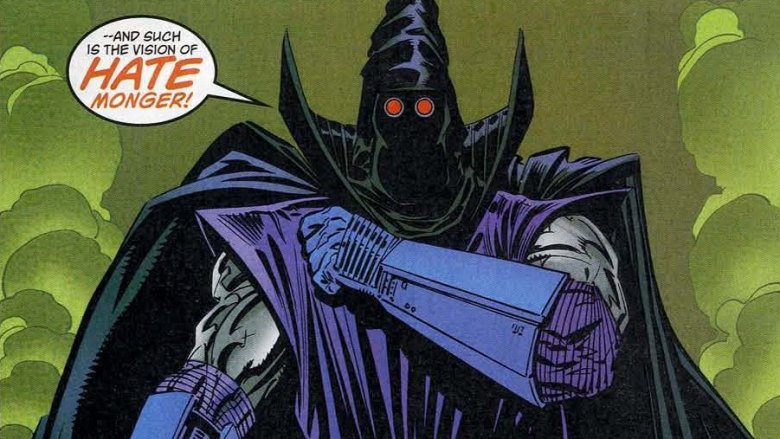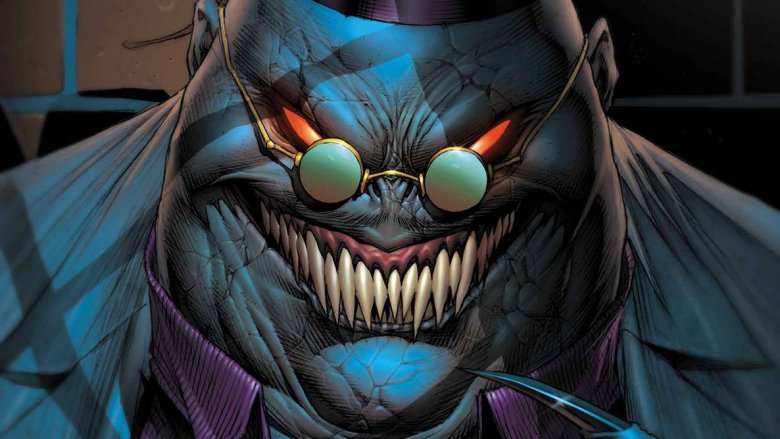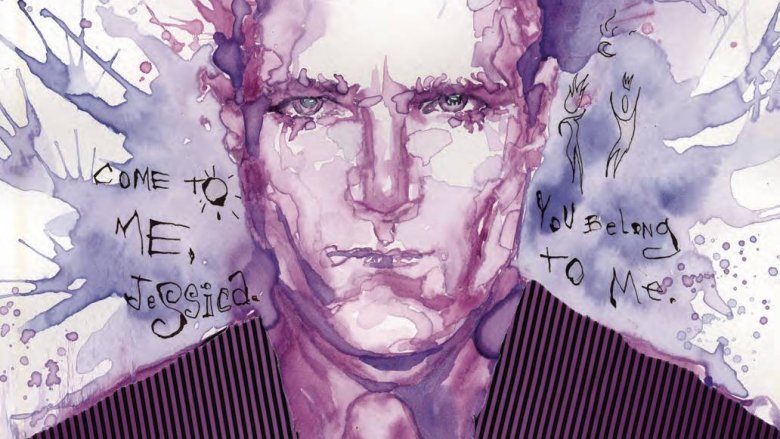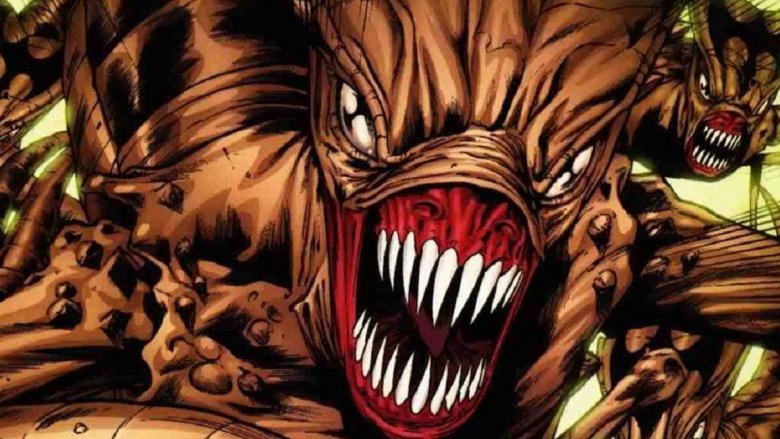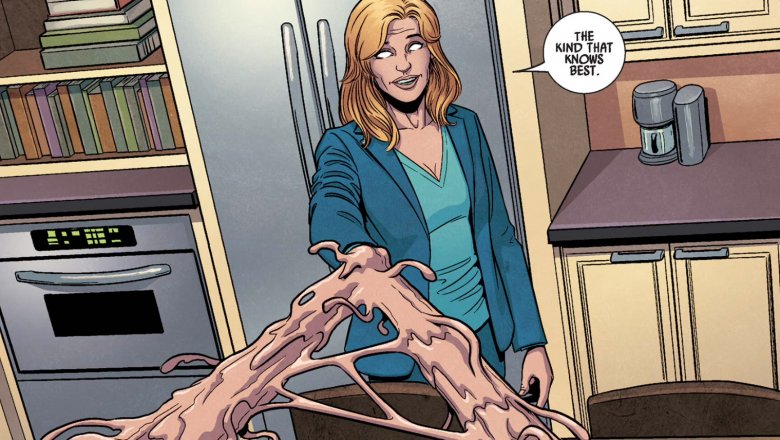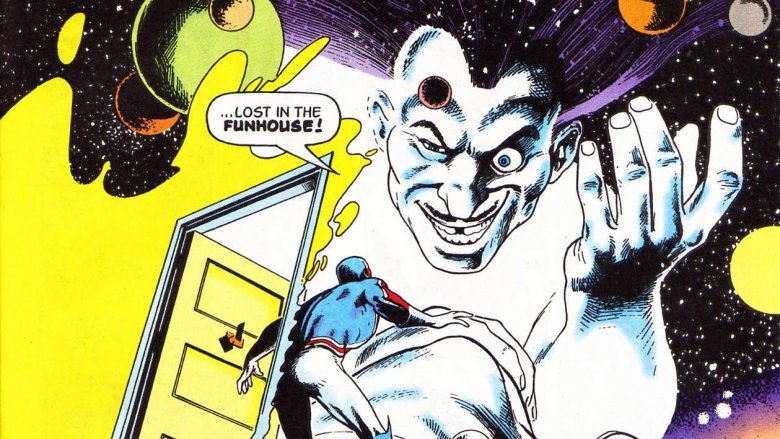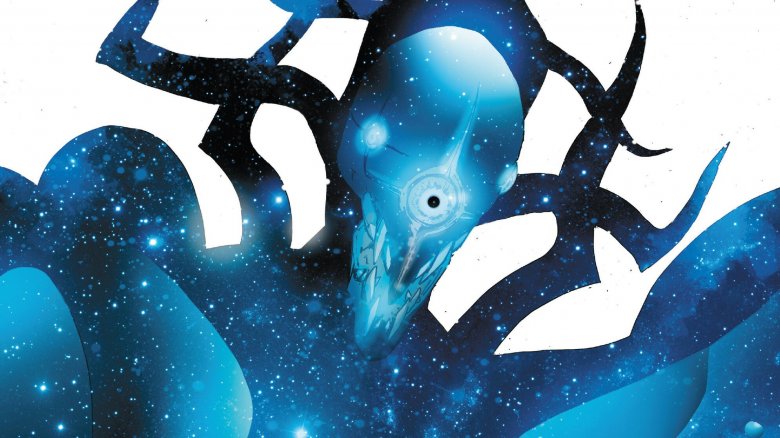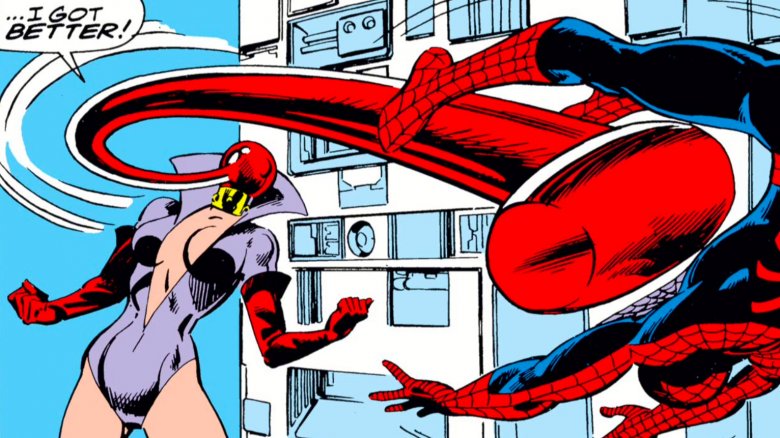Marvel Villains Who Are Scarier Than Thanos
Thanos is the villain that the Marvel Cinematic Universe has been building to since Avengers, and by the time he fully arrives on the scene in Avengers: Infinity War, he's as big as promised. Once he assembles all the Infinity Stones into his Infinity Gauntlet, he has the power to wipe out half the lives in the universe, and he does exactly that. Obviously, things didn't work out for the villain in Endgame, but that doesn't change the fact that Infinity War has the most unsettling and tragic ending of any superhero movie, and that's all the Mad Titan's doing.
So, where can you go after Thanos? Once you've had a villain who can kill half the universe with a snap of his fingers, what chance does any other villain have of being that scary or threatening? Well, that really depends on what you're afraid of, but there are certainly some villains from Marvel Comics who can give Thanos a run for his money when it comes to being frightening. Let's take a look at some of them.
Hela
Sure, Thanos killed half the universe, but he did it in the pursuit of what he saw as a higher purpose. Hela doesn't need a reason to kill. Death is who she is and what she does. Literally, she's the Norse Goddess of Death. When she kills you, you don't go on to any sort of just reward, either. If you're taken by Hela, you go to her realm of Hel and become part of her undead army. As afterlives go, it doesn't sound particularly fun. This is why Vikings are so motivated to prove their value as warriors, because only the bravest and best are chosen by the Valkyrie to spend eternity feasting in Odin's great hall of Valhalla. Everyone else, in theory, goes to Hel.
The Marvel version of Hela (renamed from the Norse Hel to differentiate the goddess from the realm) was introduced by Stan Lee and Jack Kirby in Journey into Mystery #102. She wears the intricate armor and multi-horned helmet we associate with Kirby designs, but in dark green and black, it's a far more intimidating look. Of all Thor's enemies, she's perhaps the scariest. It's hard to stop someone from killing whoever they want, after all, when they rightfully have dominion over the realm of death.
Galactus
Whether Galactus should be considered evil is the subject of some debate, both inside the Marvel Universe and in the real world. What's much more clear is that evil or not, he's terrifying. It's not that Galactus wants to hurt you. In fact, he doesn't care about you at all. He's a godlike space giant, and as such you're basically a bug to him. The problem is that Galactus is hungry, and only one thing can satisfy his hunger. To sustain his immortal life, Galactus eats entire planets, and you never know when he might choose yours.
Galactus first arrived to consume the Earth in Fantastic Four #48, also by Stan Lee and Jack Kirby. As Lee explained in the introduction to Marvel Masterworks Fantastic Four Vol. 5, which collected that story, he and Kirby came up with Galactus because they'd created so many increasingly powerful villains that a god seemed like the obvious next step. So far, Galactus has been deflected every time he's tried to devour the Earth, usually by the super-brain of Reed Richards, leader of the Fantastic Four. He keeps coming back, however, and if he ever catches Reed and the other heroes off guard or busy with something else, that'll be it. No more Earth.
Kang the Conqueror
Kang is a planner by nature, a strategist. He doesn't make a move until he's arranged everything so that he's confident that what he does is certain to go his way. That would make him a formidable villain under any circumstances, but we haven't even gotten to Kang the Conquerer's main power set. He's from the far future (a descendant of Reed Richards, in fact) and he has access to time travel. That means when he's orchestrating his manipulative plans, he can change the past to make the future he wants more likely. Anytime the Avengers face Kang, they have to realize that he may have already changed their timeline in ways they aren't even aware of.
Fighting Kang is a confusing endeavor for more reasons than that. Another Lee/Kirby creation, he first appeared in 1964's Avengers #8, but a previous time-traveling villain named Rama-Tut, who'd appeared a year earlier in Fantastic Four #19, was later revealed to be Kang from another place in his timeline. He was also at times the villain Immortus, and even the young hero Iron Lad. Thanks to the convoluted nature of time travel, you never know when more than one Kang might show up, and at times he may even be at war with different versions of himself, as in the "Kang War" storyline that started in Avengers #128. That's not a conflict anyone wants to caught up in. Make a time traveler angry, and you may soon find that you were never born.
Annihilus
Originally introduced by Lee and Kirby in Fantastic Four Annual #6, Annihilus is creepier than your average interdimensional supervillain of the 1960s. He's the ruler of the Negative Zone (at least in as much as such a realm of chaos can truly be ruled). He walks like a human, and his shape (wings aside) is roughly humanoid, but Annihilus is emphatically not a human being. His intelligence is a match for ours, but his instincts come from a whole different phylum. At heart, Annihilus is an insect—a bug. If somebody gets in his way, he's not going to talk it over. He's probably going to eat them, and if they're too big to eat, he'll sting them until they run away or crumple to the ground. He may have the power of reason, but there's no reasoning with Annihilus. There's only running or fighting, and you have to be pretty powerful to have any hope for the latter.
As the main villain in Marvel's Annihilation crossover, Annihilus led an insectoid armada through space, destroying whole planets in their wake as he made his gambit to rule the main Marvel Universe just as he rules the Negative Zone. Incapable of pity or remorse, Annihilus displayed his willingness to casually snuff out millions of lives in pursuit of his goal.
Mephisto
Nearly from the beginning, Marvel's creative team was clearly interested in building a fully fleshed-out metaphysical setting for their comics — and in the '60s, they really started testing the existing limits of superhero adventures, with conflicts facing their heroes across a dizzying array of dimensions and realms. After delving into Norse mythology with Thor — and soaring into space with the mind-bending adventures of characters like the Silver Surfer and Galactus — it was only a matter of time before they turned to traditional religious iconography for inspiration.
Created by Stan Lee and John Buscema, Marvel's Mephisto isn't technically drawn from the Bible — the co-creators were inspired by Mephistopheles from the Faust story — but he's been up to devilish mischief for more than 50 years, since his debut in 1968's The Silver Surfer #3. He's the evil entity who holds Doctor Doom's witch mother captive in his Hell. He's the one who made the deal that turned Johnny Blaze into Ghost Rider. He'll show up and say nice things to you if he thinks you might sign on his dotted line, but if you don't do what he wants, he's more than capable of inflicting great pain, both in this life and the next — and he'd likely be much more than a match for Thanos.
Shuma-Gorath
At first glance, Shuma-Gorath might just look like some kind of large cephalopod with one big eye. Unsettling to be sure, but hardly the most frightening monstrosity the Marvel Universe has to offer. The thing is, though, that's not really Shuma-Gorath. The one-eyed octopoid is just the demon's manifestation in the physical realm. Shuma-Gorath is actually part of an extra-dimensional race of beings known as the Many-Angled Ones. It ruled Earth as a god during prehistory, but was defeated by the god Crom and cast out of Earth's dimension. Ever since then, it's been trying to find its way back in.
Shuma-Gorath first appeared in a Doctor Strange story in Marvel Premiere #5, in which it took possession of Strange's teacher the Ancient One as a backdoor to the Earthly realm. Strange is forced to kill his own teacher to stop the evil within him. The name Shuma-Gorath came from a brief reference in a Robert E. Howard story, but the creature itself was created by Steve Englehart and Frank Brunner, as a way to bring some H.P. Lovecraft-style weird horror into the Marvel Universe. There have been evil gods in the Marvel Universe for at least as long as Thor's been bedeviled by Loki, but Shuma-Gorath was the first one to be inhuman and incomprehensible, which makes it way scarier.
Hate Monger
Who is the Hate-Monger? That was the mystery in his first appearance in Fantastic Four #21, a Lee/Kirby comic from 1963. He's an unnerving masked figure in a peaked hood that immediately brings to mind the Ku Klux Klan, and he has a ray gun that makes people hate each other. Originally introduced in South America, he turns out to be none other than Adolf Hitler, who assumed this new identity after fleeing death in Germany. Hitler dies at the end of that first Hate-Monger story, his legacy of hate ending at last, almost two decades later than it did in the real world.
The problem is that hate itself isn't so easy to kill. The Hate-Monger soon returned from the dead, and became an ongoing threat to both the Fantastic Four and Captain America. HYDRA scientist-turned-android Arnim Zola had acquired Hitler's genetic material and could make new clone bodies for the Hate-Monger as needed.
What makes the Hate-Monger scary is not that he's Adolf Hitler. Hitler was a normal man after all, who only had the power he gained by accumulating loyal followers. The scary thing about the Hate-Monger is the idea of Hitler and the hate he represented being impossible to kill. He just keeps coming back, with new and more powerful technology every time.
The Shadow King
The Shadow King has no body of his own. He exists entirely on the astral plane, in the realm of thoughts. He can take over anyone's body, though, and basically use it as his own, sublimating their personality as he does so. When that happens, we're not just talking about the kind of mind control that's common in superhero stories, like Hawkeye working for Loki briefly because he got tapped with a magic staff. The Shadow King doesn't just want help with some scheme—he wants to live a life, regardless of whose body he's living it in. He'll live inside you for years, and use your body to live out his every hedonistic desire. He doesn't care if he keeps the body he's using in good health, or even particularly if the body stays alive.
In his original guise of Amahl Farouk, the Shadow King was created by Chris Claremont and John Byrne for Uncanny X-Men #117, but later creators have added layers to his eternal existence. He was used as the primary villain on the X-Men-based TV series Legion, which did a pretty good job of presenting him as the chameleonic creature of corruption that he's always been in the comics.
Killgrave, the Purple Man
Killgrave, also known as the Purple Man, isn't a god, or a cosmic entity, or a non-corporeal psychic being. He's just a man. However, he has the most frightening power a man can have, and the fact that he's a regular man with regular wants and desires only makes him scarier. You see, whatever the Purple Man tells someone to do, they do. His slightest suggestion is an irresistible command. If he tells someone to stop breathing (and he has), they'll suffocate without drawing another breath. He can't even turn his power on and off. Anything he says, ever, makes everyone around him do whatever they can to make the thing he said come true.
When he was first created by Stan Lee and Joe Orlando for Daredevil #4, he was really just another 1960s supervillain, his rather intense powers just a puzzle for Daredevil to solve. It was only when Brian Michael Bendis and Michael Gaydos used him as a part of Jessica Jones' backstory in the pages of Alias that his true horrific potential was on display. What could be scarier, after all, than a villain who robs you of your autonomy? For a man to do it to a woman, especially in the context of a mature comic with feminist themes like Alias, has even more disturbing implications. Killgrave was just as terrifying on the Jessica Jones Netflix series, where he was played by David Tennant, although of course that version wasn't purple.
The Brood
Comics creators borrow ideas from elsewhere in culture all the time. Already on this list we have Mephisto (an ersatz Satan) and Shuma-Gorath (a take on H.P. Lovecraft monsters like Cthulhu and Yog-Sothoth). Even the Hate-Monger isn't exactly an original character concept. The Brood is another perfect example of this pattern. Created for 1982's Uncanny X-Men #155 by Chris Claremont and Dave Cockrum, the Brood are an alien race who are pretty directly based on the creature from Ridley Scott's 1979 film Alien.
However, in the interest of doing something similar to—but slightly different from—that film, Claremont and Cockrum created an even more viscerally frightening body horror concept. Whereas the creature from Alien implants an embryo that bursts out and kills the host, the Brood implant their victims with eggs that don't hatch out of their bodies—they take over their bodies and transform the victims into new Brood. Then the host is still trapped in there (Get Out-style) while the insectoid Brood uses the victim's memories and knowledge to more effectively conquer the galaxy. As fates worse than death go, it's a pretty rough one.
Fear comes in many shapes, and while nobody on this list would be quite so quick to murder half the population of the galaxy (although Hela and Annihilus do their best to be competitive), there are still scarier things than Thanos with the Infinity Gauntlet. Often what frightens us most is losing control of ourselves or of the world around us, and these characters give us a lot of both.
Mother
The character of Mother, created by Kieron Gillen and Jamie McKelvie for their Young Avengers run, is terrifying on a deeply held, psychological level. She's an interdimensional parasite who takes the form of Hulkling's late mother when Wiccan tries to use magic to resurrect her in Young Avengers Vol. 2 #1. At first, she looks and acts just like his real mom, but she soon turns out to be a formless slime monster who has the power to control the minds of other adults, turning parents against their kids and making it so that no other grownups will view her as a threat.
She's basically the fears of childhood wrapped up in the alienation of teenhood. What if your parents were bad people? What if they didn't love you? What if every adult in your life was secretly against you and all the adults immediately took their side? Over the course of their struggle with Mother, every Young Avenger is confronted by their own parents who've taken Mother's side, including those parents who are long dead. Ultimately the teen heroes recruit other teens to their side and are able to win the day, but what a disturbing battle to even have to fight. Mother's modus operandi cuts right to the heart of her targets, and guarantees that even a victory against her will leave an emotional toll.
Mad Jim Jaspers
Back when Captain Britain was first making a name for himself as the UK's top Marvel hero, his stories tended to involve a lot of travel to alternate Earths and strange timelines. In one such story by Dave Thorpe and Alan Davis that began in Marvel Super-Heroes #377, he met a man called Mad Jim Jaspers, who had total control over reality and was so out of his mind he had no regard for all the death and destruction his powers caused. Ultimately that Jaspers grew so out of control and powerful that his entire universe was destroyed.
Then Captain Britain came home to the main Marvel Universe, just in time to see that the Sir James Jaspers of this world, who held the potential for the same madness and even greater power, was running for Prime Minister on an anti-superhero platform. This Jaspers, who was created by Alan Moore and Alan Davis for Daredevils #9, was even more frightening and powerful because he had his act together well enough to accumulate political power — but as Captain Britain knew, the use of his reality-warping abilities would inevitably drive him insane as surely as they had his other-dimensional predecessor. Ultimately the universe was saved not by Captain Britain, but by an evil robot created by the other-worldly Jim Jaspers, which turned out to be the only thing that could defeat Prime Minister Jim Jaspers as his warping powers grew. Even as his reality was saved, Captain Britain was forced to deal with the possibility of a foe too powerful to fight and too mad to reason with.
The First Firmament
The living embodiment of all that is, Eternity has been a fixture of Marvel Comics since Steve Ditko and Stan Lee introduced him in the 1960s. He's not exactly a benevolent god (not really a god at all, in fact), but he generally seems like an okay guy, as personifications of the entire universe go. However, the current Marvel Universe is not the first universe to exist. In fact, the current incarnation of Eternity is actually the eighth such incarnation. So what if some of those previous universes are still around somewhere? What if one of them has become twisted and evil? Who'd stand a chance?
The First Firmament, introduced by Al Ewing in Ultimates 2 Vol. 2 #5, is the embodiment of the first universe that ever existed when time dawned. It created other beings out of loneliness, and when they acted against its will, it was destroyed. However, its cosmic consciousness remained in the void watching the march of time, and with each successive universe it grew angrier at the apparent usurpation of its position. When the current Eternity was weakened by cosmic events, the First Firmament returned and chained our universe, looking to regain its rightful place.
The idea of an evil universe attacking our universe is so big it almost fails to be frightening simply by being too enormous to contemplate. On the other hand, that level of vast cosmic power being wielded for evil with no regard for a single life in our universe is deeply terrifying on a cosmic, Lovecraftian level. Fortunately the Ultimates and Galactus were able to help Eternity defeat the First Firmament, but it was certainly a brush with an uncommonly big evil.
Ruby Thursday
Ruby Thursday, originally just called Ruby, is much less powerful than most of the villains on this list, but when we talk about which villains are the scariest, Ruby makes the list on the basis of how creepy and disturbing her very existence is. She was introduced by Steve Gerber and Sal Buscema in Defenders Vol. 1 #32, as a member of the Headmen. She has the body of an attractive woman, but in place of her head is a bright red shape-changing organic computer. Her inhuman head can form tentacles and weapons, but it's at its creepiest as a featureless red ball.
Her origin was never directly shown, but according to Ruby she replaced her own head with this smaller, faceless piece of technology of her own invention. How her consciousness survived (if indeed it really did), let alone how her body stays alive — none of this is addressed in the heady rush of Bronze Age Comics pseudo-science. One thing she does make clear, however, is that her ideal world is full of other people with heads just like hers. So basically, she's a scientist who cut off her own head in the name of science, then decided that her own decapitation was such a success that she wants to do it to everybody else too, whether they like it or not. No matter how silly the comics she appears in may seem on the surface, that's about as creepy as a supervillain can get.
